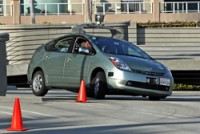Are Automated Vehicles the Future of Mining?
Back in late 2008, Rio Tinto invested in a number of automated haul trucks, which have been predominantly used in Western Australia due to mining staff shortages.

Recently, these automated vehicles officially moved their 100 millionth tonne of rock, marking a significant milestone. As automated vehicles, they can be controlled remotely by mining personnel or can be completely autonomous, operating via GPS navigation.
Given the success of these vehicles, it brings with it the wonder of the possibility that automated vehicles could become the future of mining. Not only that, but could they become the future of all vehicles?
The design of automated haul trucks were specifically aimed at increasing efficiency and reducing the risks that can come with mining. In other words, a haul truck can be sent in on an automated basis into an area that could be dangerous. If anything happens, then the truck could be damaged or destroyed, but there would be no loss of human life.
Automated vehicles and the future
The prospect of automated vehicles goes well beyond just the mining industry, though. In the future, all vehicles could be automated while still allowing for a human override if the vehicle’s AI malfunctions or ceases to work.
Out of all the companies out there looking into the possibilities of driverless cars, Google is actually one of the frontrunners. Since 2005, Google has been working on the development of driverless vehicles that aim to help reduce crashes and allow those who otherwise would no longer be able to take the wheel to do so.
The technology itself works off a combination of GPS navigation and sensors. The car is equipped with cameras and sensors so that it can identify objects, give way and stop signs, the current state of traffic lights (green, yellow, red) and other potential hazards that need to be avoided or accounted for (such as the current state of traffic on the road). Via the car’s GPS information, the car will adjust its speeds to reflect the current speed limit.
While it’s still in its early days, Google’s driverless cars have already shown substantial promise, having worked flawlessly in most on-road tests. What’s worth noting is that during the two times the any Google driverless car has been involved in an accident was due to human error. One occurred when a person took over the car controls and the second occurred when someone rammed their car into the back of the driverless vehicle.
In one promotional video for their endeavours, Google driverless car engineers took a man for a ride who suffers from almost total blindness. The vision-impaired man sat in the driver’s seat without pressing anything. The vehicle successfully took him through the drive-thru of a fast food joint and dropped him off at his local laundromat to pick up his clothes.
Of course, automated vehicles aren’t completely here yet, but the first steps towards to these technologies is already available in current vehicles. Such as sensors to prevent your car from crashing and vehicles that will reverse parallel park for you.
As each year passes, we’re moving closer and closer towards a world where automated vehicles could indeed become the norm. If they ultimately make the roads safer, that’s a great thing. As for the mining industry, if automated vehicles such as those haul trucks already being used can help make it a safer industry, then it’s a positive step forward. After all, the mining industry is one of the most dangerous trade industries in the world.
What do you think of a world with automated vehicles? Good or bad? Share your thoughts and opinions with us in the comments below.